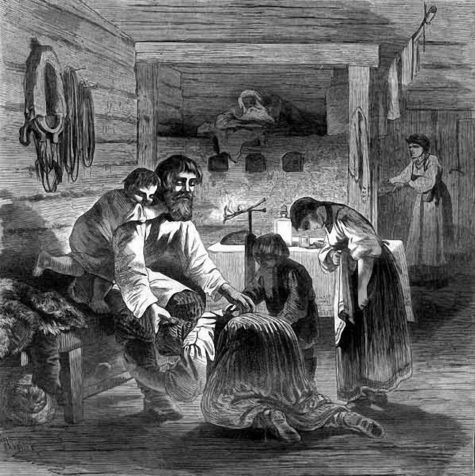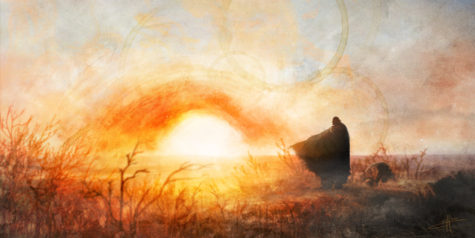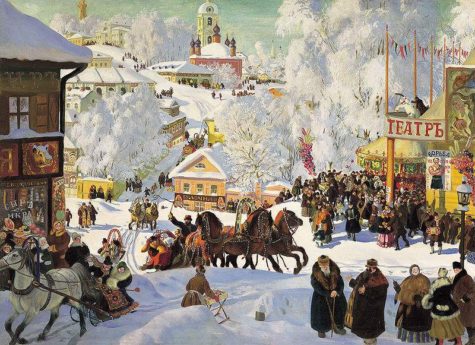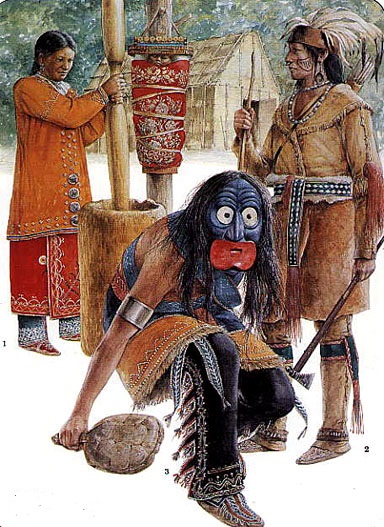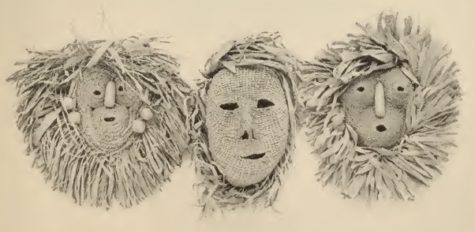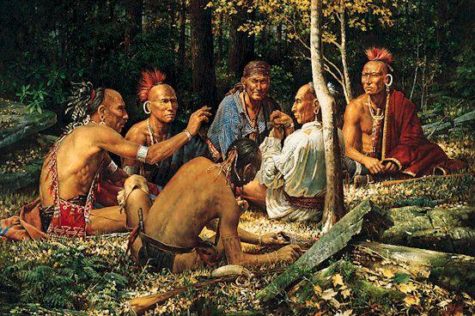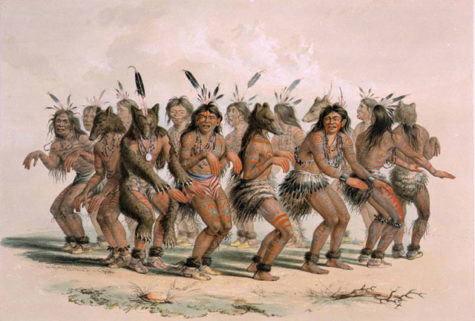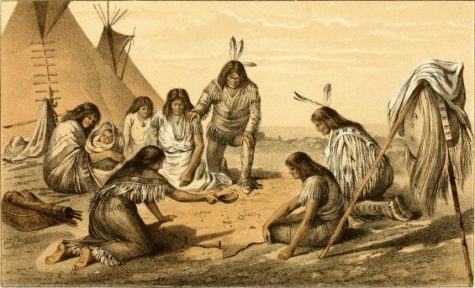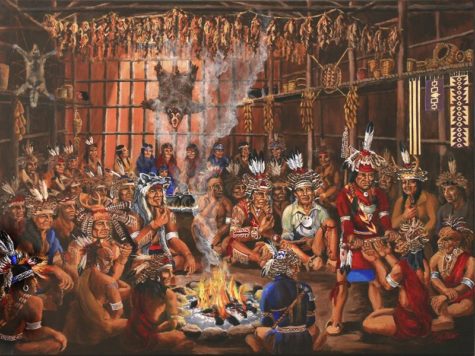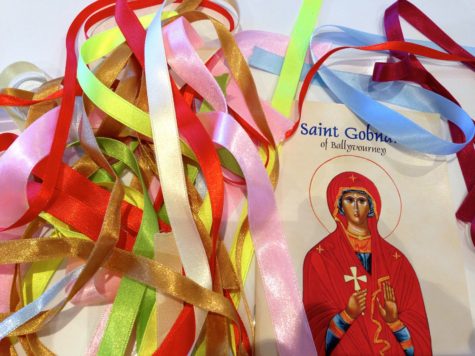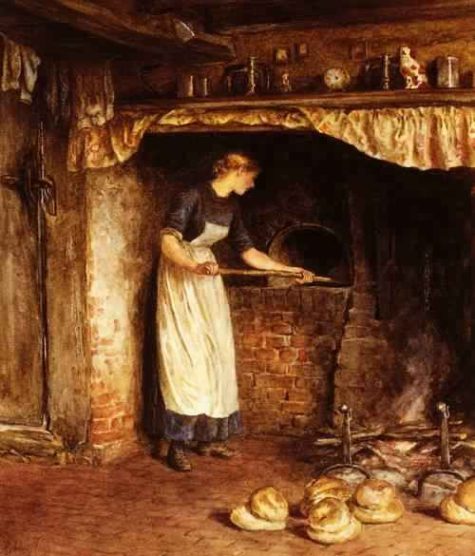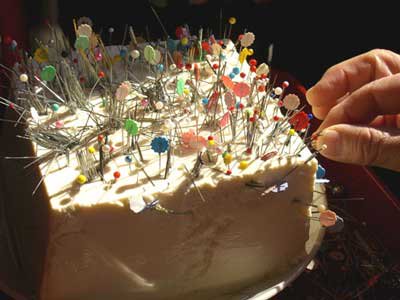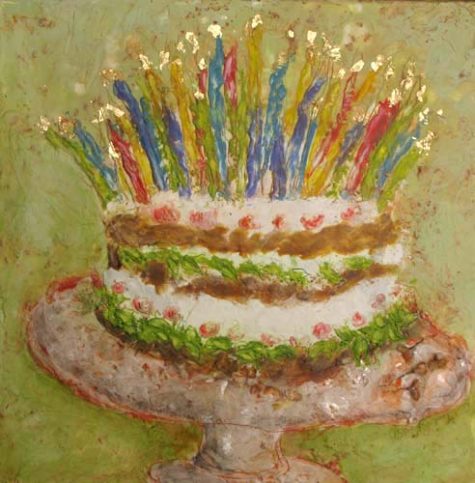Monthly Archives: February 2017
The last day of the Russian Butter Festival, also called Maslenitsa , or Cheesefare Week is called “Forgiveness Sunday.” Relatives and friends ask each other for forgiveness and might offer them small presents.
At Vespers on Sunday evening, people may make a poklon (bow) before one another and ask forgiveness. Another name for Forgiveness Sunday is “Cheesefare Sunday”, because for devout Orthodox Christians it is the last day on which dairy products may be consumed until Easter. Fish, wine and olive oil will also be forbidden on most days of Great Lent.
The day following Cheesefare Sunday is called Clean Monday, because people have confessed their sins, asked forgiveness, and begun Great Lent with a clean slate.
Here is a deeper explanation of the Catholic symbolism of this day:
Before we enter the Lenten fast, we are reminded that there can be no true fast, no genuine repentance, no reconciliation with God, unless we are at the same time reconciled with one another. A fast without mutual love is the fast of demons. We do not travel the road of Lent as isolated individuals but as members of a family. Our asceticism and fasting should not separate us from others, but should link us to them with ever-stronger bonds.
Found at: Wikipedia and other sources
Kalevala Day is celebrated in Finland on 28 February, to match Elias Lönnrot’s first version of The Kalevala in 1835. It is an official flag-raising day in Finland, and simultaneously the Day of Finnish culture. The epic poem, Kalevala is celebrated by the Finns with parades and readings from the poem.
- Themes: Creativity; Tradition; Fertility; Beginnings
- Symbols: Egg; East Wind: Poetry
- Presiding Goddess: Luonnotar
About Luonnotar:
A Finno-Ugric creatrix, Luonnotar closes the month of February with an abundance of creative, fertile energy. Her name means “daughter of earth,” and according to legend she nurtured the cosmic eggs from which the sun, moon, and stars developed. In the Kalevala, Luonnotar is metaphorically represented as the refreshing east wind – the wind of beginnings. She also created the first bard, Vainamolen.
To Do Today:
The Kalevala is the epic poem of more than twenty thousand verses that recounts the history and lore of the Finnish people. Luonnotar appears in the creation stanzas, empowering the entire ballad with her energy. If there’s anything in your life that needs an inventive approach or ingenious nudge, stand in an easterly wind today and let Luonnotar’s power restore your personal muse. If the wind doesn’t cooperate, stand instead in the breeze created by a fan facing west.
To generate fertility or internalize a little extra resourcefulness as a coping mechanism in any area of your life, make eggs part of a meal today. Cook them sunny side up for a “sunny” disposition, over easy to motivate easy transitions, or hard boiled to strengthen your backbone!
Another way to celebrate the day would be with a reading from the Kalevala, some of which can be found at Widdershins – just search the tag: Kalevala. There is also a nice Finnish Healing Spell adapted from the Kalevala on Book of Shadows
From: 365 Goddess
According to archeological evidence from 2nd century A.D. Maslenitsa may be the oldest surviving Slavic holiday. Maslenitsa has its origins in the pagan tradition. In Slavic mythology, Maslenitsa is a sun-festival, personified by the ancient god Volos, and a celebration of the imminent end of the winter. In the Christian tradition, Maslenitsa is the last week before the onset of Great Lent.
During the week of Maslenitsa, meat is already forbidden to Orthodox Christians, and it is the last week during which eggs, milk, cheese and other dairy products are permitted, leading to its name of “Cheese-fare week” or “Crepe week”. The most characteristic food of Maslenitsa is bliny thin pancakes or crepes, made from the rich foods still allowed by the Orthodox tradition that week: butter, eggs and milk. Here’s a recipe: Classic Krasnye Blini
Since Lent excludes parties, secular music, dancing and other distractions from spiritual life, Maslenitsa represents the last chance to take part in social activities that are not appropriate during the more prayerful, sober and introspective Lenten season.
In some regions, each day of Maslenitsa had its traditional activity:
Monday:
Monday may be the welcoming of “Lady Maslenitsa”. The community builds the Maslenitsa effigy out of straw (из соломы), decorated with pieces of rags, and fixed to a pole formerly known as Kostroma. It is paraded around and the first pancakes may be made and offered to the poor.
Tuesday:
On Tuesday, young men might search for a fiancée to marry after lent.
Wednesday:
On Wednesday sons-in-law may visit their mother-in-law who has prepared pancakes and invited other guests for a party.
Thursday:
Thursday may be devoted to outdoor activities. People may take off work and spend the day sledding, ice skating, snowball fights and with sleigh rides.
Friday:
On Friday sons-in-law may invite their mothers-in-law for dinner.
Saturday: Saturday may be a gathering of a young wife with her sisters-in-law to work on a good relationship.
Sunday:
Relatives and friends ask each other for forgiveness and might offer them small presents. As the culmination of the celebration people gather to “strip Lady Maslenitsa of her finery” and burn her in a bonfire. Left-over pancakes may also be thrown into the fire and Lady Maslenitsa’s ashes are buried in the snow to “fertilize the crops”.
Found at: Wikipedia
Maslyanitsa means butter in Russian, and it is also the name of the festival that says goodbye to winter and welcomes summer. From Moscow to St. Petersberg, Russians celebrate Butter Week just before their Lent fast days. The dates vary falling sometime in February or March. (In 2018, this festival begins on Feb 12).
During Lent, meat, fish, dairy products and eggs are forbidden. Furthermore, Lent also excludes parties, secular music, dancing and other distractions from the spiritual life. Thus, Maslenitsa represents the last chance to partake of dairy products and those social activities that are not appropriate during the more prayerful, sober and introspective Lenten season.
Monday is the high point of celebration, when people cook pancakes, or blini, served with honey, caviar, fresh cream and butter. The more butter there is, the hotter the sun is expected to be in the coming summer.
The most characteristic food of Maslenitsa is bliny (pancakes). Round and golden, they are made from the rich foods still allowed by the Orthodox tradition: butter, eggs and milk. Here’s an authentic traditional recipe: Classic Krasnye Blini.
Maslenitsa activities also include snowball fights, sledding, riding on swings and plenty of sleigh rides. In some regions, each day of Maslenitsa had its traditional activity: one day for sleigh-riding, another for the sons-in-law to visit their parents-in-law, another day for visiting the godparents, etc. The mascot of the celebration is usually a brightly dressed straw effigy of Lady Shrovetide, formerly known as Kostroma.
As the culmination of the celebration, on Sunday evening, Lady Maslenitsa is stripped of her finery and put to the flames of a bonfire. Any remaining blintzes (pancakes) are also thrown on the fire and Lady Maslenitsa’s ashes are buried in the snow “fertilize the crops”.
The last day of Butter Week is called “Forgiveness Sunday,” At Vespers on Sunday evening, all the people make a poklon (prostration) before one another and ask forgiveness, and thus Great Lent begins in the spirit of reconciliation and Christian love. The day following Forgiveness Sunday is called Clean Monday, because everyone has confessed their sins, asked forgiveness, and begun Great Lent with a clean slate.
Found at: Wikipedia
The Iroquois Mid-Winter Ceremony, for continuation of all life-sustaining things is a series of rituals, observed by the six tribes of the Iroquois Confederacy, which celebrates new beginnings and serves as a spiritual new year. The ceremony does not have an official date on the calendar, but rather is determined when the first new moon arrives while both the Ursa Major and Ursa Minor constellations are visible, which occurs in either February or January.
- According to one calendar, this will be Feb 19 thru Feb 28, in 2018.
- According to other star maps, Ursa Major and Ursa Minor can be seen above the horizon in northern areas all year.
The major events of the Midwinter Ceremony consist of the Tobacco Invocation, the Dream Sharing Ritual, the False Face Society, the Peach Stone Game, the Bear Dance, the White Dog Sacrifice, the Great Feather Dance, The Big Heads and the Stirring of the Ashes, and a closing ceremony. These events take place over the course of ten days with no specific order, but generally begin with The Big Heads and the Stirring of the Ashes and ends with a closing ceremony.
- Big Heads and the Stirring of the Ashes
Generally, the first of the activities is the Big Heads and the Stirring of the Ashes. A group of anonymous messengers called the Big Heads visit the tribe’s longhouse. They wear ceremonial outfits made of buffalo skins and braided corn husk masks which symbolize the hunt and the harvest.
They also carry a corn mashing mallet used in the Stirring of the Ashes. In the Stirring of the Ashes, the Big Heads go from house to house stirring the ashes in fire pits of each household while they ask that the New Year brings renewal and fertility to the land. This is gesture of gratitude to “The Creator” as ashes serve as a symbol of the earth and the cycle of life.
- Tobacco Invocation
The next ritual to usually take place after the Stirring of the Ashes is the Tobacco Invocation. It consists of sprinkling tobacco in the embers remaining from the Stirring of the Ashes or outright smoking as an offering. The smoke that rises from the burning tobacco symbolically rises to the heavens to sign of giving thanks and to give messages to the Creator and other spirits.
- Dream Sharing Ritual
The Dream Sharing Ritual serves as a ritual of healing. It serves as a way to get rid of troubling thoughts and a way to make wishes come true as the Iroquois believe that dreams represent ways to resolve real life problems. Tribe members would describe their dreams in front of others so they may give their interpretation of the events that take place in the dreams.
The person who has the best interpretation has to then aid the tribe member in seeing that the issue gets resolved. For dreams that represent physical or mental ailments, they dreamer is sent to the False Face Society which is a group of medicine men.
- False Face Society
The False Face Society is a group of Iroquois medicine men who wear masks made out of wood. These people can consist of either men or women, but only the men wear the traditional masks. They are said to have the ability to scare off the evil spirits that cause illness. Those who are deemed of needing healing during the Dream Sharing Ritual are sent to these medicine men during their gathering. Healing rituals consist generally of blowing or rubbing hot ashes from a fire on those in need of curing.
- Bear Dance
The Bear Dance is another healing ritual that coincides with the False Face Society gathering. It is conducted by both men and women by lumbering and waddling like bear counter clockwise around a person that was ill.
This can be done either privately or publicly. The Iroquois believed that this dance can heal the problems of person that were placed upon them from the previous year.
- Peach Stone Game
The next event is the Peach Stone Game. This game symbolizes the Iroquois creation story where the Creator and his evil brother played a game in competition during the creation of the Earth, the renewal of the Earth like the Stirring of the Ashes, and the battle for survival of crops.
The game consists of six peach pits which are colored black (through burning for example) on one side. They are placed in a bowl and shaken while two teams take turns placing bets in the form of beans on how many black sides will face up. The teams are given an equal number of beans, and the first team to lose all of their beans loses the match. The results of this game are also used to predict the success of the coming year’s harvest.
- White Dog Sacrifice
One of the following events is the White Dog Sacrifice. Originally, this ritual consisted of killing a white dog, a symbol of purity, by strangulation as to leave no marks. The dog was then adorned in red paint, feathers, beads, wampum, and ribbons. It was placed on fire along with tobacco so that smoke may carry their, sacrifice, and prayers to the Creator.
Today, however, the act of killing a white dog is replaced by a white basket due to the animal cruelty in the original proceedings of the ritual.
- Great Feather Dance
The final event before the closing ceremonies is the Great Feather Dance. The dance is held on eight night of the nine-day festival, and serves as way to welcome the new spiritual year as well as thanking the Creator. Dancers wear traditional tribal clothing and turtle shell rattles, and dance to two singers that sit facing each other. They give thanks to all the Creator has bestowed upon them during the previous year by dancing in rhythm and shaking the rattles.
The event finally concludes with a closing ceremony where a speaker presenting an overview of the events and address of thanksgiving. New tribal council members who will lead the people until the next event are chosen and presented to the crowd. By the end of this ceremony, all members of the tribe are purified and a new year is welcomed.
Source: First Nation Rituals
Gobnait is Irish for Abigail which means “Brings Joy”. As the patron saint of beekeepers, her name also has been anglicized as Deborah, meaning “Honey Bee.” This Irish saint is a version of the deity Domna, patroness of sacred stones and cairns. The center of her worship was at Ballybourney, Co. Cork, Ireland.
Her feast day, February 11 is called “Pattern Day” in the parishes of Dún Chaoin and in Baile Bhúirne, and is regarded as both holiday and holy day. In one tradition, a medieval wooden carving of Gobnait, about two feet high, kept in a church drawer during the year, is brought out. Parishioners bring a ribbon to ”measure” the statue. This ribbon is then taken home to use when special blessings are needed.
Daeboreum (literally “Great Full Moon”) is a Korean holiday that celebrates the first full moon of the new year of the lunar Korean calendar which is the Korean version of the First Full Moon Festival. This holiday is accompanied by many traditions. The 2017 date is February 11, in 2018 the date is March 2.
Many customs and games are traditional on this day, which is also sometimes called the Great Fifteenth. The Fifteenth, or Full Moon Day, marks the end of the New Year season in Korea and is regarded as the final opportunity to ensure good luck for the coming year.
It is considered lucky on this day for people to routinely repeat their actions nine times—particularly children, who compete with each other to see how many “lucky nines” they can achieve before the day is over.
It is common to celebrate the Great Fifteenth with kite flying and kite fighting, which is done by covering the strings with glass dust and then crossing them so that they rub together as they fly. The string held by the more skillfully manipulated kite eventually cuts through the string of the less successful kite, sending it crashing to the ground.
Another popular sport on this day is the tug-of-war. In some areas, an entire town or county is divided into two opposing teams. It is widely believed that the winners will bring in a plentiful crop and will be protected from disease in the coming year.
One familiar custom is to crack nuts with one’s teeth. It is believed that this practice will help keep one’s teeth healthy for the year.
In the countryside, people climb mountains, braving cold weather, trying to catch the first rise of the moon. It is said that the first person to see the moon rise will have good luck all year or a wish will be granted.
People play the traditional game named Jwibulnori (쥐불놀이) the night before Daeboreum. They burn the dry grass on ridges between rice fields while children whirl around cans full of holes, through which charcoal fire blaze. These cans fertilize the fields and get rid of harmful worms that destroy the new crops.
For breakfast, a five-“grain” rice consisting of rice, millet, Indian millet, beans, and red beans is served (gok includes grains and beans). This is eaten with various dried herbs. One of the special foods of Daeboreum is Yaksik (약식 / 藥食). This treat is made of glutinous rice, chestnuts, pinenuts, honey, sauce, and sesame oil.
Also there is wine drinking for Daeboreum. It called ‘Ear-quickening wine (귀밝이술)’. This alcohol means that if someone drank this alcohol, he or she would be quick to hear and hear good news for one year.
On this day, Koreans traditionally do not give any food to dogs since it is believed that dogs that eat on this day will contract gad flies and become ill during the coming summer.
Sources: Wikipedia and Answers.com
The Fornacalia, a festival in honor of Fornax, the goddess of furnaces, was held in order that bread might be properly baked, and to bless the ovens used to dry grain. This festival was movable, and could have been held any time between Febuary 5th to February 17th.
Each year the Curio Maximus (a citizen charged with ensuring the observance of curial religious feasts) would announce the date of the Fornacalia and post a separate notice for each curia (neighborhood) in the Forum, probably indicating where each curia should gather for the final part of the celebration.
It is believed that every family in the curia brought far, that is, spelt (a kind of grain), to be toasted in the meeting hall and sacrificed to ensure that bread in the household ovens wouldn’t be burnt in the coming year. Then the curiae assembled for a collective feast.
If on the last day of the Fornacalia (17th of February) anyone had missed the feast or was not a member of a curia (or had forgotten which one he belonged to), he could make a private sacrifice at the general assembly of all the curiae called the Quirinalia. It is believed by some, that because of this the Romans called the Quirinalia the Stultorum feriae, the ‘Feast of Fools.’
To Do Today:
The Fornacalia was a festival of ovens, in which Fornax was invoked by baking wheat breads and other grain-related foods. So think about dusting off your cookbooks, especially any recipes from your family, and start baking! Even people pressed for time can usually make a bath of bread from frozen dough.
If you only own a microwave, have no fear – microwaveable soft-dough pretzels are readily available in the freezer section of your supermarket. Or, simpler still, have toast for breakfast this morning to internalize Fornax’s warm emotions. On the other hand, if you’d like to give Fornax a much needed break from her toils at your place, go out and eat! Just make sure to have some bread as part of your meal to welcome Fornax to your feast.
Finally, take any dried bread you have and crumble it up for the birds. Focus on your desire for love and closeness in your life. The birds will convey your wishes to Fornax, the heavens, and the four corners of creation.
A Ritual For Today
- Color: Brown
- Element: Fire
- Offerings: Give some of the loaves of bread to those who have need of it.
- Daily Meal: Everything baked – breads, cakes, pies, casseroles.
This ritual should be performed in the kitchen, with the altar built on top of the stove or inside the oven. Set a brown cloth with a red candle and many loaves of bread on wooden trays.
Invocation to Fornax
Goddess of the Oven
Lady of Fire Enclosed,
Sacred Baker of our food,
We all started as dough,
Raw and soft and unformed,
And we were patted into shape
By those who raised us,
Yet we could not bring ourselves
Fully grown to the table
Until we had endured
The hardening flame.
Be kind to us, Lady!
As we go through life
Let us not be scorched
Or spared the fire
But bring us gently through
To be our final selves.
Chant:
Baker of the Loaf of Earth
We endure your fire
(One of the loaves is broken and handed around and shared, some more are set aside to eat later, and then the rest are taken to some deserving place and donated.)
- Ritual from: Pagan Book of Hours.org
- Other information collected from various sources
In the Hari-Kuyo ceremony, Japanese women gather once a year on Febuary 8th at Shinto shrines or Buddhist temples to thank their worn out needles and pins for good service.
It is also a time to value the small, everyday objects of daily living and to wish for progress in one’s needle work. In what is known as the Festival of Broken Needles, women gather to offer a funeral-type service by laying the needles to rest in soft jelly cakes or tofu. This burial is meant to bring rest to the needles and wrap them with tenderness and gratitude. This practice reflects the animist belief that all beings and objects have a soul.
Another aspect of the ceremony is the consideration for “the value of small things.” The concept of Mottainai, or not being wasteful, is related to the usefulness of the needles. These small but important tools would give long, useful service throughout the year. They were not to be lost or wasted nor carelessly replaced.
Further to the idea of laying the needles to rest for good service is the idea that women have many secret sorrows in life. These sorrows are often passed to the needles during long hours of stitching and the needles are thought to take on the burden of some of these sorrows, thus taking them away with the stitching that they do. This “rest” is brought to the needles in appreciation for their faithful service.
Source: Stitchtress Stumbles
The seventh day of the Chinese New Year, traditionally known as Rénrì (人日, the common man’s birthday), is the day when everyone grows one year older. In some overseas Chinese communities in Southeast Asia, such as Malaysia and Singapore, it is also the day when tossed raw fish salad, yusheng, is eaten for continued wealth and prosperity.
This day is filled with omens about human fate. For example, any person or animal born on this day is considered doubly blessed and destined for prosperity. So, consider taking out a divination tool today and seeing what fate holds for you.
In Chinese mythology, Nüwa is the goddess who created the world. She created the animals on different days, and human beings on the seventh day after the creation of the world. The order of creation is as follows:
- First of zhengyue: Chicken
- Second of zhengyue: Dog
- Third of zhengyue: Boar
- Fourth of zhengyue: Sheep
- Fifth of zhengyue: Cow
- Sixth of zhengyue: Horse
- Seventh of zhengyue: Human.
Hence, Chinese tradition has set the first day of zhengyue as the “birthday” of the chicken, the second day of zhengyue as the “birthday” of the dog, etc. And the seventh day of zhengyue is viewed as the common “birthday” of all human beings.
To generate Nüwa’s luck or organizational skills in your life, make and carry a clay Nüwa charm. Get some modeling clay from a toy store (if possible, choose a color that suits your goal, like green for money). If you can’t get clay, bubblegum will work, too. Shape this into a symbol of your goal, saying:
From Nüwa blessings poured,
Luck and order be restored.
Renri is the day, when all common men are growing a year older and the day is celebrated with certain foods according to the origin of the people. The ingredients of the dishes have a symbolic meaning and they should enhance health.
To honour Nüwa’s creation of animals either vegetable dishes will be eaten or a raw fish and vegetable salad called yusheng. Yusheng literally means “raw fish” but since “fish (鱼)” is commonly conflated with its homophone “abundance (余)”, Yúshēng (鱼生) is interpreted as a homonym for Yúshēng (余升) meaning an increase in abundance. Therefore, yusheng is considered a symbol of abundance, prosperity and vigor.
Almost no Chinese celebrate on this day. Some people just eat potatoes with angel hair noodle. The long noodle stands for longevity. In the past, seven vegetables which can repel the evil spirits and sickness away were eaten. They are as follows:
- Celery, Shepherd’s Purse Spinach, Green Onion, Garlic, Mugwort and Colewort
Ancient Chinese had a tradition of wearing head ornaments called rensheng, which were made of ribbon or gold and represented humans. People also climbed mountains and composed poems. Emperors after the Tang dynasty granted ribbon rensheng to their subjects and held festivities with them. If there were good weather on Renri, it was considered that people will have a year of peace and prosperity.
Fireworks and huapao are lit, so Renri celebrates the “birthday” of fire as well.
Since the first days of zhengyue are considered “birthdays” of different animals, Chinese people avoid killing the animals on their respective birthdays and punishing prisoners on Renri.
Nowadays in zhengyue, Renri is celebrated as part of the Chinese New Year. Chinese people prepare lucky food in the new year, where the “seven vegetable soup,” “seven vegetable congee” and “jidi congee” are specially prepared for Renri. Malaysian and Singaporean Chinese use the “seven-colored raw fish” instead of the “seven vegetable soup”.
In Japan, Renri is called Jinjitsu. It is one of the five seasonal festivals. It is celebrated on January 7. It is also known as Nanakusa no sekku, “the feast of seven herbs”, from the custom of eating seven-herb kayu to ensure good health for the coming year.
The celebration of the feast in Japan was moved from the seventh day of the first lunar month to the seventh day of January during the Meiji period, when Japan adopted the Gregorian calendar.
Sources: 365 Goddess and wikipedia
